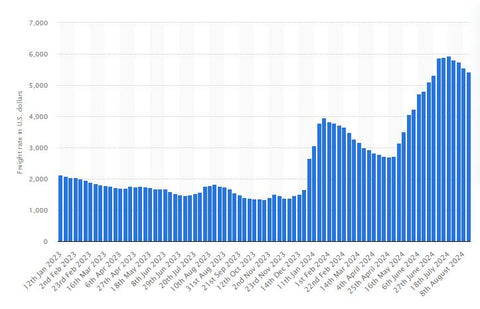No Products in the Cart

Author: Dr Shawn Martin
Executive Summary
This article aims to provide an in-depth analysis of the recent hike in US customs tariffs on personal protective equipment (PPE) from China, with a specific focus on disposable gloves. It also examines the changes in sea freight costs and their implications for the US market. The goal is to inform our customers about the trends and potential impacts on their operations in the coming months and years, helping them make informed decisions especially in light of the US elections and its implications on China imports.
Impact of Customs Hike on Disposable Gloves
Overview of Tariff Changes
The US administration has announced significant increases in tariffs on PPE imports from China. Starting January 1, 2025, tariffs on rubber medical and surgical gloves will rise to 50%, and further increase to 100% by January 1, 2026. These measures are part of a broader strategy to reduce dependency on foreign manufacturing and bolster domestic production.
Immediate Financial Impact
The immediate impact of these tariff hikes will be a substantial increase in the cost of disposable gloves. Healthcare providers, who are heavily reliant on these products for infection control and daily operations, will face significant budgetary pressures. The price of rubber medical gloves could potentially double, leading to budget shortfalls for hospitals already grappling with rising healthcare costs.
Supply Chain Disruptions
The increased tariffs may also cause disruptions in the availability of disposable gloves. Importers will likely seek alternative suppliers outside of China, but shifting supply chains is not an immediate solution. During this transition, healthcare providers may face shortages or delays in receiving the gloves they need.
Changes in Freight Costs
Recent Trends in Sea Freight Costs
Another less noticed trend, is on the ocean shipping costs. The Sea freight costs have experienced significant fluctuations over the past two years. During the COVID-19 pandemic, freight rates surged due to disruptions in the supply chain, port congestion, and increased demand for shipping containers. After reaching record highs, rates began to decline as supply chain issues started to resolve and demand stabilized.
Current Freight Cost Dynamics
As of mid-2024, the global container freight rate index showed a significant increase, with rates hitting over $5,900 for a 40-foot container in July 2024. This was a sharp rise from the lowest point in October 2023, when rates were around $1,342. These fluctuations highlight the volatility in the shipping industry, influenced by various factors such as global economic conditions, supply chain disruptions, and geopolitical events, and oil prices.
Graph: Sea Freight Cost Trends (2023-2024)

Outlook for 2024-2026
Increased Imports to Avoid Higher Premiums
In anticipation of the higher tariffs, importers are likely to increase their imports of disposable gloves and other PPE from China before the tariffs take effect. This surge in imports could lead to temporary supply gluts, followed by potential shortages once the tariffs are in place.
Long-Term Market Adjustments
Over the long term, the market is expected to adjust to the new tariff regime. Domestic production of disposable gloves may increase as manufacturers seek to capitalize on the higher prices of imported goods. However, this transition will take time, and the market may experience volatility during this period.
Freight Cost Projections
Freight costs are expected to remain volatile in the near term, influenced by ongoing supply chain disruptions and geopolitical events. However, as the global economy stabilizes, freight rates may gradually decline, providing some relief to importers.
Impact of US Elections on Trade with China
The outcome of the 2024 US elections will have a significant impact on US-China trade relations. A Republican victory could lead to a continuation or intensification of existing tariffs and trade restrictions. Conversely, a Democratic victory might signal a potential shift towards a more conciliatory approach.
Conclusion
The recent hike in US customs tariffs on disposable gloves from China, coupled with fluctuating sea freight costs, presents significant challenges for the US market. Healthcare providers and importers will need to navigate these changes carefully to mitigate their impact. By understanding these trends and preparing for potential disruptions, businesses can better position themselves for the future. The outcome of the 2024 US elections will introduce an additional layer of uncertainty into this already complex landscape. By understanding these trends and preparing for potential disruptions, businesses can better position themselves for the future.
If you have any questions or need further assistance, please feel free to reach out.
1: Impact of New U.S. Tariffs on Facemasks and Disposable Gloves: 2US Makers of Masks and Gloves Get Lifeline: Higher Tariffs on Chinese-Made Products: 3Freight Market Update: May 2024